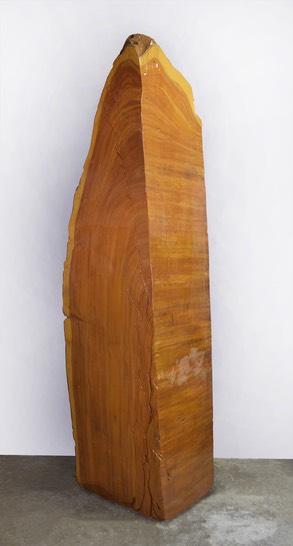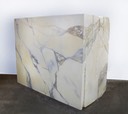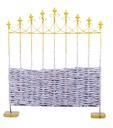
INTERIM_02
Jessie Laino: FORM/FUNCTION/POWER
Whether wrapping unruly bundles of hay in plastic, stripping abandoned Christmas trees or polishing a junked muffler, Jessie Laino re-animates the discarded artifacts of her world. By plumbing the emotional relationships she has with cast-off objects, she invites viewers to follow suit, and that inquiry can be transformative. Laino’s work has shamanistic properties, offering receptive viewers an illuminating experience.
In Laino’s words, “I construct ambiguous environments or autonomous objects that provoke conversation with the viewer an inch outside of their normal memory patterns.” That’s just what she achieves in her solo show, FORM, FUNCTION, POWER at LnS Gallery. Co-directors, Luisa Lignarolo and Sergio Cernuda became enamored of her work at a New World School of the Arts (NWSA) alumni exhibition in 2017. “We were taken aback by her ability to find and create beauty from an unconventional source,” said Lignarolo.
Laino’s family story revolves around faux finishing and building – skills she learned from her parents before exploring advanced art ideas in college. Her mom operated a faux finishing business and regularly brought young Jessie to the studio. “She would say ‘Here, take the feather and run it down the column,’ and she would follow behind me with the buffing brush and another colored vein,” recalls the artist, who treasures and re-uses her mom’s old sample boards. Marbleizing was one of the illusions Laino learned to create, transforming a nondescript surface into one of prestige and value.
Her father was also a “magician.” A builder and contractor, he taught her to fabricate whatever she envisioned, using construction tools and materials. “He would bring home a lot of different items from restaurants he would remodel, so a lot of fixtures in our house were from Dennys or IHOP or whatever,” she says.
Whether mufflers, ropes, tires, even plastic bags, very few things appear repellent to Laino. They provoke questions. Who discarded this beautiful crimson comforter and why? What late-night conversations did it witness? She develops intimate relationships with the objects she “adopts.” Regarding a muffler: “It's been created; it got put on a car; it went through this whole process, and somehow it’s just on the corner, but if I take it, I want to wash it, polish it, hang out with it and give it a chance that it never would have had.” By implication, she invites us all to invest more deeply in chance encounters.
To create Interim, Laino carved a large rigid foam slab, salvaged from the street, into the form of a sequoia trunk segment. She then meticulously applied a faux finish (Thanks, Mom!) provoking visitors to question their perceptions.
Then, captivated by the powerful technology of marble quarrying, she fabricated her own massive block, again using lightweight rigid foam. She disguised its surfaces with veining and distinctive tool marks and moved From Now On into the gallery, where visitors ponder: Did she just find this formidable marble block or purchase it? Then they discover, no, it’s carved from foam.
In re-contextualizing and transforming everyday objects, Laino acknowledges precedents. Arte Povera pioneer Jannis Kounellis filled exhibition spaces with coal, shoes and sewing machines. Eva Hesse is one of Laino’s heroes, and she also draws on the Surrealists, Fluxus, and Minimalism, but makes their ideas her own. In T_01, for example, with a restrained intervention of paint and resin, she elevates a discarded tire to an object of refined elegance.
To create Suspend_01 Laino wove dyed cotton cords through a piece of discarded metal mesh. Varying their tension and density across the form, she evokes diverse associations: Victorian corset, weathered plastic beach chair, makeshift strainer. Alternatively, its blue gradient and jewel-like sheen can as readily suggest a nuanced ocean/sky vista. “I don’t want to give anyone an answer,” challenges Laino. “I want you to have a question and maybe make your own answer.”
Growing up in Miami and attending NWSA, Laino observed downtown in all its grit and glamour. And with a student budget, “We had to make something out of nothing. I was using lunch bags and polyurethane and cigarette butts I would find on the ground.” Gradually recycling or “scrapping” became a moral choice. Committed environmentalists, LnS directors Luisa Lignarolo and Sergio Cernuda applaud Laino’s espousal of sustainability. As Luisa Lignarolo notes about Miami, “You can find tire shreds off an expressway and tree trunk remains on the side of a residential neighborhood within blocks of each other.”
But generating unsettlingly beautiful “objets d’art” from exploded tire scraps is another matter. That’s alchemy.
Laino normally cycles among several works in progress. “It's fun for me when I have something just pop into my mind and I can make it happen,” she said. That could be spontaneously shrink-wrapping a plastic bag onto a scrap of wire mesh to create the arresting GB_01. By contrast, Holidays are about Family involved the meditative peeling of bark from an abandoned Christmas tree, stripping that iconic symbol down to its un-ornamented essence. Others, like her bicycle-powered electrical generation installations, created for a TED-X talk and re-fashioned for the Young At Arts Museum, require extensive R&D to balance technology and esthetics. Each approach engages a different kind of energy.
Laino takes recycling to a new level in Sediment_01, casting a large concrete slab and then hammering it apart to create a mass of rocks – in varying tones. Distributing them on the gallery floor, she drapes them with a sheer blue fabric to mysteriously conjure a rushing river.
Introducing the exhibition’s staging, Sergio Cernuda remarks, “Our vision is to curate a clean, rather minimalist presentation. We want every piece to breathe and captivate the viewer.” That restraint sets a suitably meditative tone.
Form, Function, Power culminates in the project room, where laser sensors and fans generate a kinetic surprise to complement those quiet revelations inspired by Laino’s sculptures. “The works are just there to exist as a neutral place for the viewer,” affirms the artist, “a place where the familiar and unfamiliar exist simultaneously.”
George Fishman









